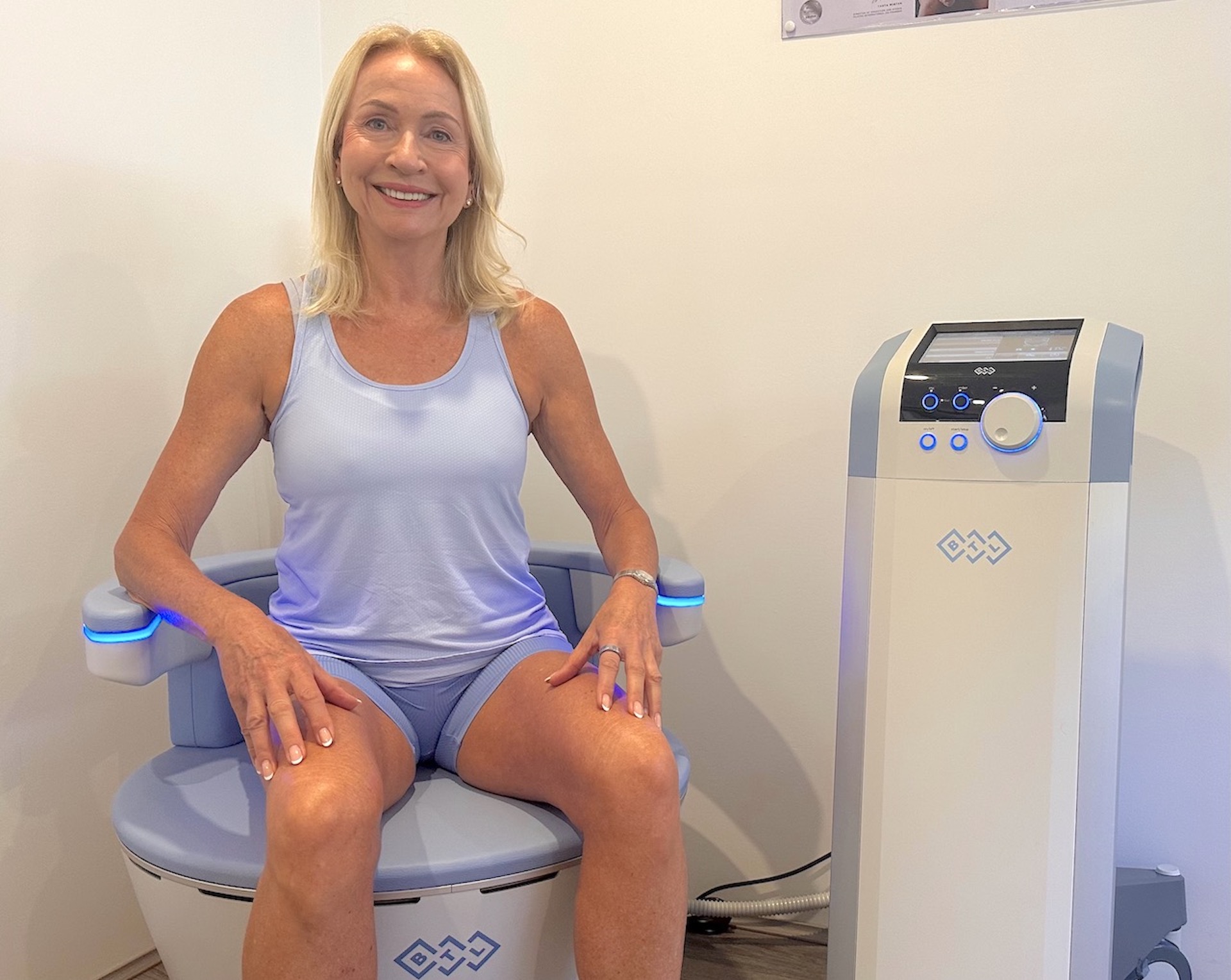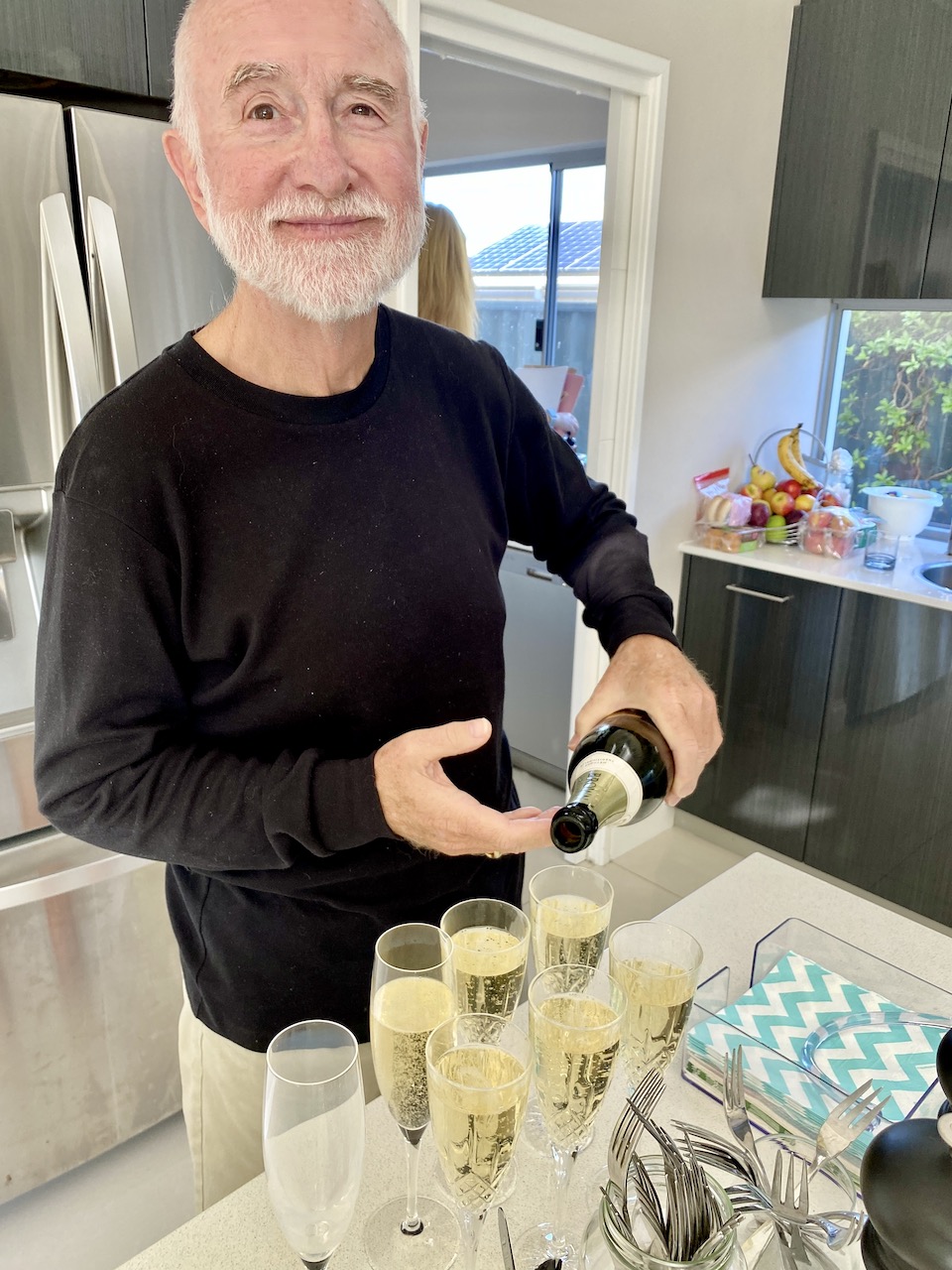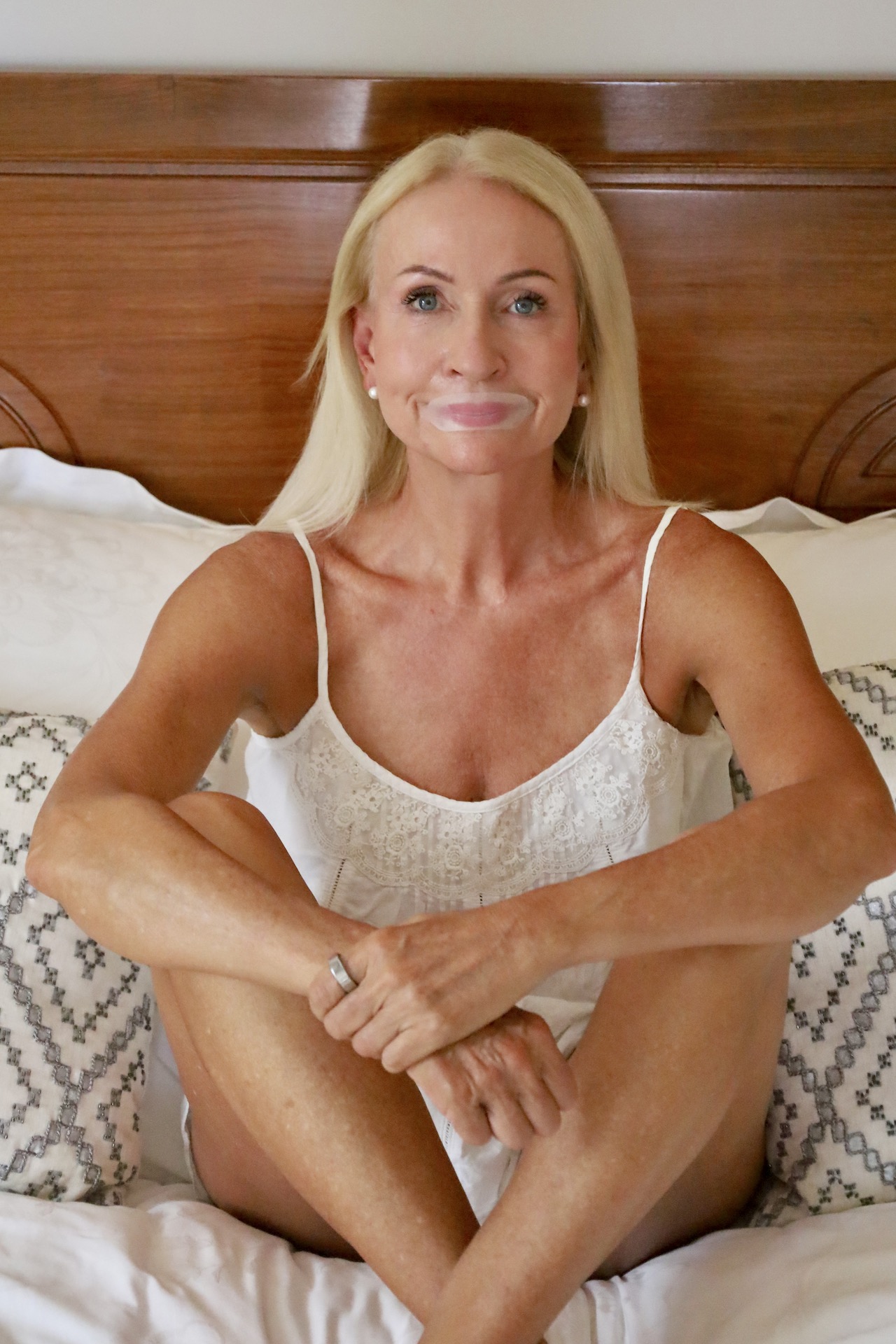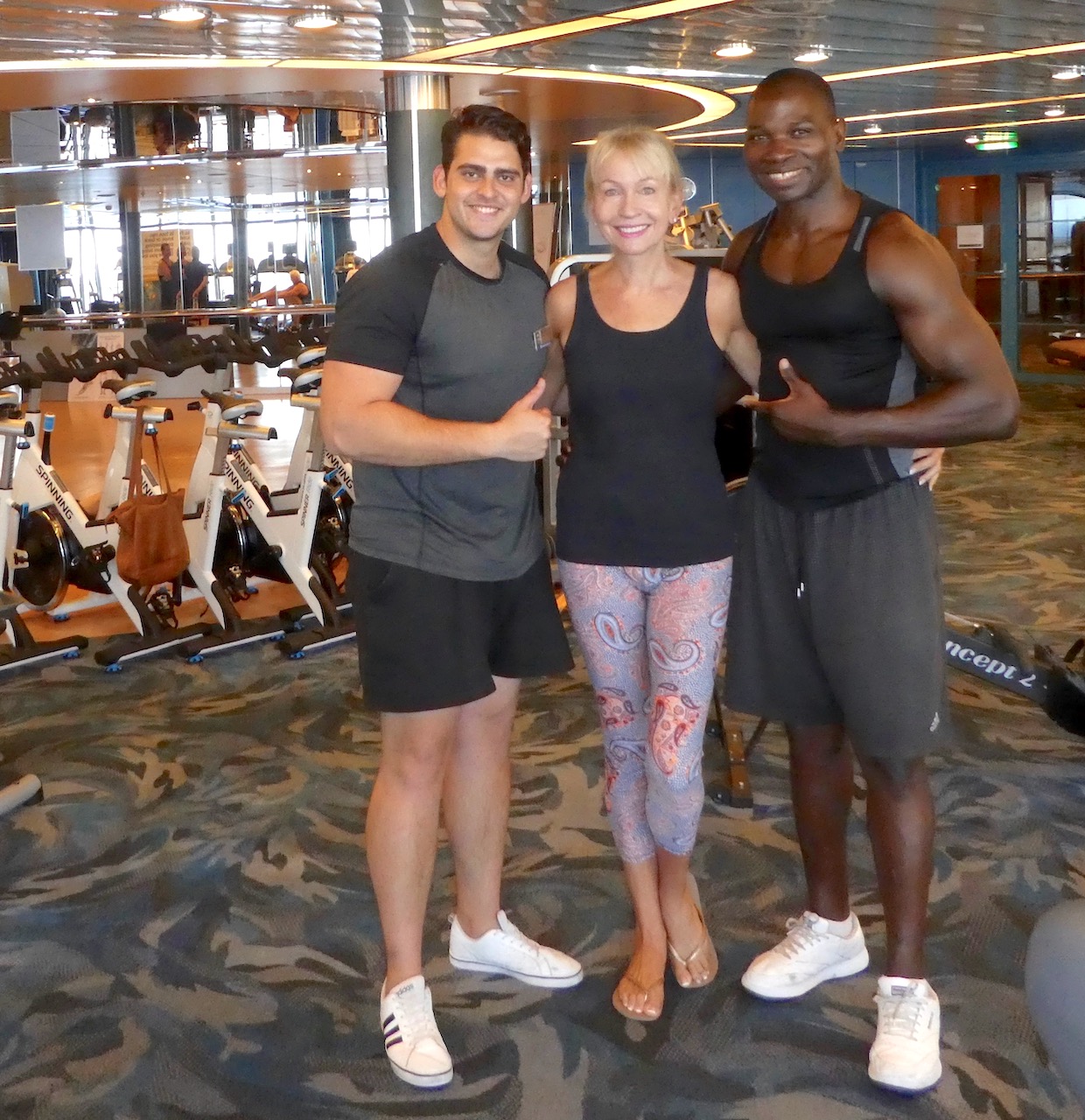Overactive bladder; Little Britain’s terrifically incontinent Mrs Emery; girding my loins; overturning taboos; OAB diagnosis, incontinence definitions and dubious drugs; Kegels and pelvic physio with TENS therapy; the Cooch Ball; surgery… the unkindest cut of all?*; the Emsella chair
(* “The unkindest cut of all” was one of my late dad’s favourite jokes, referring to the practice of male circumcision.Though probably politically incorrect today, it still makes me smile, so I’ll take that chance.)
Here’s a blogpost that’s been a long, long time in the making… more than 15 years. During that time, I’ve personally researched just about every treatment for urinary urge and frequency, from Kegels to TENS, from the Cooch Ball to the drug solifenacin. The latest is the Emsella chair.

Remember BBC 1’s outrageous series Little Britain? And the terrifically incontinent Mrs Emery, played by comedian David Walliams? Several sketches show her peeing uncontrollable torrents in public places, like the doctor’s office, a farmer’s market or a supermarket. Part of why it’s (arguably) funny is that she seems to have no idea it’s happening, even as the yellow puddle spreads around her feet. Of course, it would be impossible to make TV like this today. No one would dare to air it.

So, what causes the annoying need-to-wee syndrome? It’s different for different people – but for me, I suspect it was sparked by a sharp and sustained peri-menopausal drop in the hormone oestrogen. I also seem to remember having just come back home to Singapore from a trip to Europe… something in the water I drank there? Your guess is as good as mine.
Girding my loins (so to speak)
As a magazine writer and editor for the glossy and gorgeous Expat Living Singapore (EL, see website here), I had wonderful opportunities to write about all sorts of subjects – travel, restaurants, family matters, but especially health and wellness – in an authentically first-person, tell-it-all style that our readers came to love.
I even had my own monthly health column in EL that was unrelated to providing advertisers with editorial content. (That’s rather rare nowadays, unfortunately – and it’s also why I take most of what little mainstream media content I still read with a bucket of salt.) Not many subjects were taboo in those days – except maybe homosexuality, in a country where it was literally still a crime to be gay… and possibly still is.
When I proposed writing a feature article on middle-age bladder issues, however, my fellow editors were horrified. No, that was too personal, too embarrassing. Not to mention deeply unglamorous. Please don’t go there! So I reluctantly shelved the idea, and I think that was a pity. Now, many years later, I’m even less embarrassed to speak out than I was back then… one of the perks of growing older?

Overturning Taboos
Most of those suffering from urinary urge and frequency don’t even tell their own doctors about it. So it’s hard to know how many people live with this inconvenient truth. More than half of all women over the age of 50, as estimated by a major NHI study.
There’s no doubt that bladder woes are still taboo… even between friends. In my opinion, no subject that affects the daily lives of so many people should be shrouded in shame and secrecy.
Diagnosing overactive bladder
Back in 2010 or so, an expensive Singapore urologist issued me with a diagnosis of idiopathic overactive bladder (OAB) – and a cheeky bill for over S$3,000.
To be clear, I’m not necessarily using the word “idiopathic” here as a slur on the urologist’s intelligence. (Although, come to think of it… )
As I found out, it simply meant he didn’t know what was causing the issue. “Yes, Ms Maree, it’s clear that you feel the urge to pee more often is necessary or convenient. But we have no idea why.“
Much of the $3K fee was justified by his having performed a cystoscopy on me: passing a camera up the urethra – ouch, eina! – while I was wide awake and necessarily spreadeagled, so as to observe my misbehaving bladder from the inside. Nothing untoward was to be seen, and additional functional tests involving peeing into a special toilet that measured flow, volume and pressure seemed to show that the bladder was working properly. Hmm.
Definitions of overactive bladder
Urge incontinence is the intense need to pee immediately, and is often caused by overactive bladder (OAB). OAB, in turn, is often caused by low oestrogen levels associated with menopause. Certain medications and caffeinated beverages could do it; so can being overweight, or having weak pelvic floor muscles.
Stress incontinence, on the other hand, is the tendency to leak urine while jumping, lifting, sneezing or even laughing – and is directly associated with a weak pelvic floor. Having given birth is a major risk factor.

Drugs for overactive bladder
All my expensive urologist could do was to prescribe a medication to relax the bladder detrusor muscle that was suspected of squeezing the bladder into overactivity. Vesicare is the brand name; solifenacin the active ingredient.
Since then, I’ve been taking the stuff on and off for years (at the lower dose of 5mg a day, as opposed to 10mg), but with uncertain effect. It never solved the problem. And things have been no worse in the need-to-pee department since I completely stopped this medication about a year ago. (That was when I spent 11 nights in Joondalup Private Hospital following a burst appendix. Here’s that thrilling story. Riddled with antibiotics, painkillers etc., and feeling lucky to still be alive, I was even more reluctant than usual to take an apparently inefficacious drug with possibly deleterious side effects like constipation and dry eyes.)
My good friend and fellow-sufferer Caroline (not her real name), was recently prescribed 5mg Ditropan (oxybutynin) three times daily. She took it for less than a week, she says. Apart from its advertised side-effects of “harming brain health” and increasing risk of dementia, she found it gave her dry mouth and worsened her existing dry eye symptoms. Scarily, she could actually feel it affecting her mental health.
If the past four-and-a-half years haven’t taught us to question Big Pharma’s “safe and effective” narrative, we really haven’t been paying attention.
Kegels
Right from the start, years before consulting a doctor, I of course gave Kegels a thorough go. The beauty of these pelvic floor exercises is their invisibility… you can do them in the car, at your desk, during meetings… no one could possibly know about your internal machinations unless you inappropriately told them.
Over the course of at least a year, hundreds of thousands of pelvic floor clenches punctuated my every commute to work, every walk through Singapore’s Botanic Gardens, Fort Canning Park or along the East Coast. The main effect was a remarkable and sometimes inconvenient surge in libido. (You’ve been warned.) No change in the need-to-pee department, unfortunately.
I’ve since heard that Kegels done incorrectly – and how to tell whether you’re doing them correctly? – can over-tighten the pelvic floor, making incontinence worse. Apparently, it’s equally important to be able to relax those muscles.
Pelvic Physio
Targeted physiotherapy is another option. I tried it a couple of years ago with the super-fit, lovely and highly qualified Kate Fosdike at Lift Pelvic Physiotherapy here in Joondalup, Perth WA. Finding my pelvic muscles to be healthy – hurrah! – and the general southern environment apparently in fairly good condition, she took me through the entire professional gamut of treatments for urinary urgency and frequency. (Lots more info on this here.)
I’d been quite hopeful about the final, most advanced step: TENS therapy. TENS stands for transcutaneous electrical nerve stimulation; conveniently, you do it at home, alone. Basically, it’s a small, battery-operated device that delivers gentle electrical impulses through the skin to target specific nerves. For OAB, it’s supposed to “interrupt the abnormal nerve signals that trigger involuntary bladder contractions”, thereby reducing the urge to pee.

I bought the intravaginal probe from her – it now languishes lonely in a bedroom drawer – and she rented the TENS control device to me for a small fee. I did it religiously, as you tend to do when you’re paying for treatment yourself. Unfortunately, whatever it’s been shown to do for many other people, it didn’t work for me and so I gave it up.
Cooch Ball
“Coochee” is American slang for, er, vulva. I’d say “fanny”, but that’s how Americans sometimes refer to one’s bum – you know, as in “fanny pack”. They can’t use the word bum as you or I might, because in the US a bum is a deadbeat.

My Cooch Ball still sits in my bathroom, and I still use it now and then… when I remember. And I’m still embarrassed to have spent US$75 plus shipping on a smallish plastic ball with a cheap little inflator.
It’s supposed to relax those overtight muscles I referred to above. You perch on it for two to three minutes a day, making sure it’s squarely (or should that be roundly?) under the perineum.
So, no one can say I haven’t tried everything. Everything short of surgery, that is. I’m deeply sceptical of surgery for a problem like this.

Surgery: “Best thing I ever did”?
I know a jolly middle-aged South African woman – let’s call her Barbara – whose stress incontinence was affecting her long-distance running. She underwent a urinary sling procedure a couple of years ago, which I heard solved her problem. “Best thing I ever did,”* she was quoted as saying.
The phrase “Best thing I ever did” chills me to the bone when it’s used in relation to surgery. I’ve heard it from some of my closest friends:
- one who had breast implant surgery, now known to cause a plethora of serious health issues;
-
another who had a hysterectomy, soon to be followed by various other surgeries for complaints that I can’t help suspecting were at least partly due to the hormone disruption caused by the first surgery. And that’s to mention just two.
The Emsella Chair
So, here’s the treatment modality that eventually got me to blog about urinary incontinence. Eden Beach Pilates came up on my Facebook feed a few weeks ago, offering, in addition to its Pilates services: The Emsella chair, “a revolutionary non-invasive technology designed to fast track the strength in pelvic floor muscles activation in just three weeks, contributing to improved core stability, enhanced posture, and overall well-being”. (All the info is here.)
Eden Beach is one of the newish, “Living the Dream” coastal suburbs north of us in Iluka, Perth. It’s an easy drive for me – less than 20 minutes. I had the promised 15-minute phone interview with Eden Beach Pilates co-owner Mark – a great, simpatico guy with a broad and deep background in physical fitness, nutrition and more, whose partner in life and business is the sweet and gorgeous Tímea. (You can check them out on their website video.)
Without making any guarantees, Mark thought I had a good chance of benefitting from Emsella. So, with nothing to lose but the $A1,500 fee for six sessions over three weeks, I signed up.
Key benefits?
One of the key benefits of this non-invasive treatment, according to the website, is that you remain fully clothed throughout. My friend Caroline (mentioned above) was not impressed with the “fully clothed” bit: “Goodness knows, for that price I want to get down and dirty with a happy ending every time.”
Someone had to say it… and it may as well be Caroline.

How it felt
A bit weird to begin with, but you soon get used to it. You’re carefully positioned on the flat surface of the Emsella chair, with your perineum in the exact spot to receive the HIFEM energy that causes intense pelvic-floor muscle contractions. A single 28-minute session delivers about 11,000 “supramaximal” contractions, leading to “muscle re-education”. And no, somehow it’s not erotic in any way.
Tímea also gave me some valuable advice on how to do Kegels, targeting in turn each of the three pelvic floor layers:
- urethral (like you’re preventing urine flow);
-
vaginal (if you’re a woman, you know exactly how); and
-
rectal (like you’re preventing a fart, a concept you may not quite grasp if you’re a man).
Some people feel immediate benefit, she explained. Others feel the treatment “kicking in”, almost like flicking a switch, after three sessions. Still others start to experience gradual improvement in the weeks following treatment. As for me, the jury is still out.
Nevertheless, I’m pretty sure the Emsella chair is doing a lot of people a lot of good. It’s not just for women; they’ve had great success with men too, especially for treating UI following prostate surgery. What’s more, it’s not just for bladder woes – one of its other functions is to improve “intimate health” which of course just means sex.

During my visits, I’ve had a lot of excellent input both from Mark and Tímea – and some great discussions about a wide range of health subjects. The Emsella chair represents a whopping six-figure investment on their part, and their commitment to the programme is almost palpable.
From everything I’ve seen and heard so far, they’re a sincere, principled couple doing good work in the health space… and in an area where this kind of expertise is sorely needed.
Up next?
Well, Roy and I are in Cape Town this week, so I’ll probably do some posting about that trip on my other blog: Travels with Verne and Roy. See you there!







